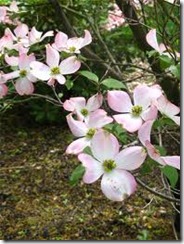-
Dogwood blossoms signal an end to winter and the coming of spring. However, homeowners often fail to recognize the growth habits of dogwood and plant the trees in inappropriate locations in their landscape. The University of Kentucky College of Agriculture points out that dogwoods naturally grow as understory trees, receiving cooling filtered shade from giant oaks, hickories and maples and nourishment from deep layers of leaf litter those giants provide. The best prevention for the long list of diseases that affect dogwood is to plant the tree where it will receive some filtered shade, enrich the soil where it is planted with compost, and mulch the tree with a deep layer of composted wood chips and leaf mold.
Dogwood Anthracnose
-
Dogwood anthracnose has spread westward across the U.S., killing or disfiguring landscape and wild trees alike. As of 2009, it had not progressed west of Kentucky. The disease first presents as purple bordered spots and tan blotches on the leaves of a dogwood. The spots may enlarge and kill the entire leaf. Infected leaves will not drop off the tree in fall and may remain on the tree until the following spring. Trunk sprouts may develop on infected trees. Infection will eventually spread from the foliage to the twigs and trunk, forming cankers on the trunk. To minimize the risk of infection, plant dogwoods where air circulation is good and standing water is not present. Eastern sun exposure with some mid-day and late-day shade is ideal. Clean foliage and dead twigs in the fall and prune trunk sprouts after the tree is dormant. Fungicide treatment may save valuable specimens.
Spot Anthracnose
-
Though the name is similar, spot anthracnose does not normally carry the same dire consequences as dogwood anthracnose. Spot anthracnose is common in cool, wet springs. Small spots appear on the leaves and flower bracts. Later in the year the spots may fall completely out of the leaves, mimicking insect damage. Leaf litter and dead twigs host the fungus through the winter. Careful cleaning of fallen leaves and removal of dead material should control the disease. If the disease is very prevalent one year, fungicide treatment can be used as a preventative the following spring.
Septoria Leaf Spot
-
If quarter-inch spots develop late in the summer on dogwood leaves, it may be septoria leaf spot. While the spots may look very much like dogwood anthracnose, they will not spread. Septoria leaf spot will do little damage and usually appears about the time the leaves would normally start changing color and dropping.
Powdery Mildew
-
The white dusty growth normally apparent with powdery mildew in other species is not as prominent in dogwood. Powdery mildew favors hot and humid conditions but is retarded by rain. Fungicide treatment for powdery mildew can help get young trees established disease-free. It would only be called for in established trees in severe cases.


Deprecated: strpos(): Passing null to parameter #1 ($haystack) of type string is deprecated in /home/agriviek8Qv/agriviet.net/public_html/wp-includes/comment-template.php on line 2522